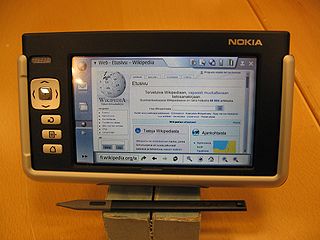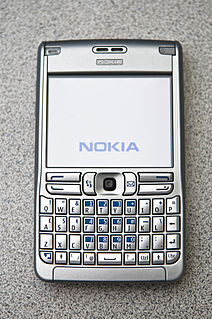Related Research Articles

NMT is an automatic cellular phone system specified by Nordic telecommunications administrations (PTTs) and opened for service on 1 October 1981 as a response to the increasing congestion and heavy requirements of the manual mobile phone networks: ARP (150 MHz) in Finland, MTD (450 MHz) in Sweden and Denmark, and OLT in Norway.
IS-54 and IS-136 are second-generation (2G) mobile phone systems, known as Digital AMPS (D-AMPS), and a further development of the North American 1G mobile system Advanced Mobile Phone System (AMPS). It was once prevalent throughout the Americas, particularly in the United States and Canada since the first commercial network was deployed in 1993. D-AMPS is considered end-of-life, and existing networks have mostly been replaced by GSM/GPRS or CDMA2000 technologies.
The signalling system used on the rail transport in Norway is regulated by the Regulations of December 4, 2001 no. 1336 about signals and signs on the state's railway network and connected private tracks.

A KVM switch is a hardware device that allows a user to control multiple computers from one or more sets of keyboards, video monitors, and mice.

The Nokia 770 Internet Tablet is a wireless Internet appliance from Nokia, originally announced at the LinuxWorld Summit in New York City on 25 May 2005. It is designed for wireless Internet browsing and email functions and includes software such as Internet radio, an RSS news reader, ebook reader, image viewer and media players for selected types of media.
Autotel is a radiotelephone service which was the "missing link" between earlier MTS/IMTS and later cellular telephone services. It used digital signaling for supervisory messages, except the voice channel was analog. This system was not cellular, as it used existent high-power VHF channels. This system was developed for rural British Columbia, Canada, where building a network of low-power cellular terminals to cover a forest would have been prohibitively expensive.

The Nokia E61 is a smartphone from the Eseries range, a S60 3rd Edition device targeting business users in the European market. It was announced as part of the new Eseries business line on 12 October 2005 along with the Nokia E60 and E70. As of Q4 2006 Cingular and Rogers Wireless have deployed a similar yet restricted version designated the Nokia E62 in the North American and Brazilian markets. The E62 is substantially similar but without an 802.11 WiFi chipset or W-CDMA (UMTS) 3G support. E61 supports 900/1800/1900 bands, while E62 can operate in 850/900/1800/1900 in order to support American networks.

The Motorola MicroTAC is a cellular phone first manufactured as an analog version in 1989. GSM-compatible and TDMA/Dual-Mode versions were introduced in 1994. The MicroTAC introduced an new "flip" design, where the "mouthpiece" folded over the keypad, although on later production the "mouthpiece" was actually located in the base of the phone, along with the ringer. This set the standard and became the model for modern flip phones today. Its predecessor was the much larger Motorola DynaTAC and it was succeeded by the Motorola StarTAC in 1996. "TAC" was an abbreviation of "Total Area Coverage" in all three models.
The form factor of a mobile phone is its size, shape, and style, as well as the layout and position of its major components.

The Nokia E52 and Nokia E55 are smartphones from Nokia's business-oriented Eseries range. They run Symbian OS v9.3. The E55 was announced on 16 February 2009, whilst the E52 was announced later on 6 May 2009. They are both physically and functionally identical, except that the E55 has a 'half-QWERTY' keyboard, similar to the SureType keyboard on BlackBerry Pearl, whereas the E52 revision has a traditional T9 keypad.

The Nokia N900 is a smartphone made by Nokia. It supersedes the Nokia N810. Its default operating system, Maemo 5, is a Linux-based OS originally developed for the Nokia 770 Internet Tablet. It is the first Nokia device based upon the Texas Instruments OMAP3 microprocessor with the ARM Cortex-A8 core. Unlike the three Nokia Internet tablets preceding it, the Nokia N900 is the first Maemo device to include phone functionality.
The Nokia C6-01 is a Symbian^3 smartphone from the Nokia Cseries. The C6-01 display features comes with a 3.2in AMOLED display with capacitive touchscreen capabilities and Nokia's ClearBlack technology for improved outdoor visibility. The smartphone was released on November 4, 2010 for €260, excluding taxes and subsidies.

The Nokia E6-00 is a smartphone running the Symbian^3 operating system. It supersedes the Nokia E72 as the new Symbian business mobility solution from Nokia following its announcement on 12 April 2011. It shipped with the new "Symbian Anna" version of Symbian^3, and originally retailed for 340 euros before taxes.

The Nokia N9 is a smartphone developed by Nokia, running on the Linux-based MeeGo mobile operating system. Announced in June 2011 and released in September, it was the first and only device from Nokia with MeeGo, partly because of the company's partnership with Microsoft announced that year. It was initially released in three colors: black, cyan and magenta, before a white version was announced at Nokia World 2011.

The Nokia Lumia 620 is an entry-level smartphone designed, developed and marketed by Nokia. It is the successor to the Lumia 610, and is one of the first Nokia phones to implement Windows Phone 8 alongside the Nokia Lumia 920 and Nokia Lumia 820. Although sharing a similar name with the Lumia 610, the Lumia 620 is a major overhaul over its predecessor, employing a 1.0 GHz dual-core processor. It also has exchangeable back covers which come in black, white, magenta, yellow, cyan etc.

The Nokia Lumia 2520 is a Windows RT tablet computer originally developed by Nokia. It is Nokia's first and only Windows-based tablet, and the company's first tablet since its Nokia Internet Tablet line. Sharing its design and marketed with the Nokia Lumia series of Windows Phone products, the device incorporates a quad-core Snapdragon 800 chip with 4G LTE support, along with a 10.1-inch (26 cm) 1080p display and an optional "Power Keyboard" dock adding additional battery capacity, USB ports, and a physical hardware keyboard. Following a period of speculation and leaks, the Lumia 2520 was officially unveiled on 22 October 2013, and released in North America on 21 November 2013.
The Nokia Actionman is a mobile phone from Nokia which has been discontinued. It was launched in January 1984 and used the NMT 450 network. It has a monochromic LCD display. The phone is meant to be kept in cars. It only supports calling features. Multimedia and Messaging are not supported by the Actionman. It has 100 channels which can be changed via the numeric keypad.
The Nokia Actionman II is a revised edition of Nokia Actionman. It was launched in May 1984, 6 months after the launch of Actionman. It used the NMT 450 network. It has a monochromic LCD display. This car phone only supports calling features. Multimedia and Messaging are not supported by the Actionman. It has 100 channels which can be changed via the advanced numeric keypad of the mobile. The phone has a signal indicator to indicate the signal and frequency.
The Nokia Talkman 320F is a car phone which is discontinued. It is a rare phone which is no longer available. It was released in August 1984, after the release of Nokia Actionman and Nokia Actionman II. Its features are the same as the previous two versions. It has a storage memory of 184 contacts. It used the NMT 450 network. The phone is a heavy model Nokia weighing about 4.7 kg. Its monochrome LCD is suitable for displaying contacts. This model lacks messaging and data services. The battery gives a stand by backup up to 10 hours and a talk time up to 60 minutes.

The Nokia 101 is an analogue mobile phone from Nokia released in 1992 that have variants for the NMT, AMPS and ETACS cellular networks. The 101 is considered to have been a significant handset for Nokia, one that started the company's major success in the market that decade. It was the first model in the new 3-digit naming strategy for analogue handsets.
References
- ↑ "Nokia Talkman 620 (NMT450) | Nokia Museum" . Retrieved 2020-01-25.